
![]()
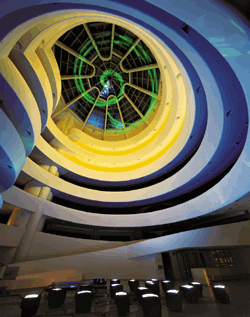
No artist has had a greater influence in imagining and realizing the artistic potential of video and television than Korean-born Nam June Paik. Through a vast array of installations, videotapes, global television productions, films, and performances, Paik has reshaped our perceptions of the temporal image in contemporary art. The Worlds of Nam June Paik transforms the Guggenheim Museum into a celebration of the moving image and an appreciation of Paik's impact on the art of the late-twentieth century.
Video Commune, a Web site created for the occasion by Electronic Arts Intermix and the Guggenheim Museum, draws from EAI's extensive documentation of Paik's single-channel videotapes to present an interactive view of his collaborations with other artists, dancers, and musicians.This exhibition is sponsored by ![]()
The commissioning and
production of the site-specific works in the rotunda,
Sweet and Sublime and Jacob's Ladder, are
made possible by The Bohen Foundation
Additional support is provided by The
Rockefeller Foundation and ![]() National Endowment for
the Arts
National Endowment for
the Arts
Top: Nam June Paik in collaboration with Norman Ballard, Paul Garrin, David Hartnett, and Stephen Vitiello, Modulation in Sync, 2000. Three-channel video and stereo sound installation with 100 monitors, seven projectors, two lasers, water, mirrors, projection screens, and metal structure, variable dimensions. Installation view at the Solomon R. Guggenheim Museum, New York, 1999; test for The Worlds of Nam June Paik. Commissioning and production of the fully realized works Sweet and Sublime and Jacob's Ladder made possible by The Bohen Foundation. Photo by David Heald.
Paik's initial artistic explorations of the mass media of television were presented in his first solo exhibition in 1963, Exposition of Music—Electronic Television, at the Galerie Parnass in Wuppertal, Germany. This milestone exhibition featured Paikís prepared televisions. Paik altered the sets to distort their reception of broadcast transmissions and scattered them about the room, on their sides and upside down. He also created interactive video works that transformed the viewers' relationship to the medium. With these first steps began an astonishing effusion of ideas and invention that over the next 30 years would play a profound role in the introduction and acceptance of the electronic moving image into the realm of art.
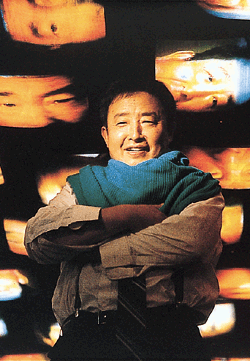
Nam June Paik, 1986. Photo by Rainer Rosenow.

Pyramid II, 1997. Laser,
prisms, motors, and mirrored chamber. 325.1 x 375.9 x
121.9 cm. Courtesy of the artist. Photo by David
Heald.
The
presentation of the works in the High Gallery is made
possible by the generous support of Samsung
Electronics
![]()
At the center of The Worlds of Nam June Paik is Modulation in Sync (2000), which includes two laser installations created with Norman Ballard for the museum rotunda that transform Frank Lloyd Wrightís architecture into a dynamic audiovisual space. Projected onto the rotunda oculus, Sweet and Sublime is a rapidly changing display of geometric shapes that echo Wrightís innovative design. In Jacob's Ladder, laser projections pass through a seven-story waterfall that cascades from the top of the museum. On the rotunda floor, a cluster of television monitors, with their screens facing up, project a pulsing display of rapidly changing imagery. Video projections along the ramp edges aimed towards the center of the rotunda provide a visual link between the images on the ground and those on the oculus, symbolizing the connections between Paik's historical remaking of video into an artist's medium and his latest transformation of laser into a dramatic "postvideo" treatment of energy and light.
The museum's Tower Gallery houses a selection of Paik's early works, including audio and video recordings and key sculptural and interactive works from the 1960s and early '70s. These early prepared television and interactive video pieces, including Magnet TV (1965) and Participation TV (1963), offer a sophisticated, radical treatment of the ways in which interactions with technology can yield new visual experiences.
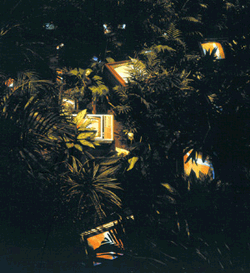
TV Garden, 1982 version. Single-channel video installation with live plants and monitors; color, sound; variable dimensions. Collection of the artist. © The Estate of Peter Moore/VAGA, NYC.
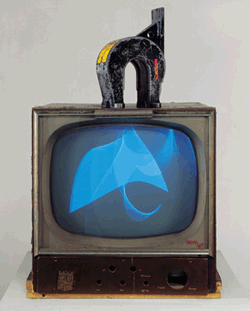
The Tower Gallery also features video and photo documentation of Paik's early Fluxus performance work, showing the connections between his performance art and his later transformation of the medium of video. A tribute to Charlotte Moorman, Paik's great collaborator in performance, is also on view, including TV Cello (1971), a transformation of the instrument through video created especially for Moorman by Paik, along with videos and photographs that celebrate their unique artistic relationship. In addition, the Paik/Abe Video Synthesizer (1969), one of the first artist-made video image processors, is installed with a selection of videotapes the artist produced with this innovative technology. Adjacent to the gallery, a single-channel screening room presents continuous showings of a selection of Paik's videos and television productions from the '60s to the present.
Magnet TV, 1965. Television and magnet; black-and-white, silent; variable dimensions. Whitney Museum of American Art, New York, Purchase, with funds from Dieter Rosenkranz 86.60a-b. © The Estate of Peter Moore/VAGA, NYC.Nam June Paik's art and career embody the virtues of change and recognize artís powerful role in helping us understand the world as it changes around us. The Worlds of Nam June Paik reflects the scope of Paik's remarkable career—from his transformation of broadcast television and video to his reconfiguration of laser into a new form of sculptural and installation art. His unique achievements, the precedents set by his creative accomplishments, and the wide range of his work attest to the key role Paik has played in expanding our understanding and definition of the arts through media. By inaugurating the millennium with The Worlds of Nam June Paik, the Guggenheim Museum not only acknowledges his importance but also testifies to the extraordinary impact the moving image will have on the art of the 21st century.
—John G. Hanhardt, Senior Curator of Film and Media Arts
The Worlds of Nam June Paik has received additional funds from Korean Cultural Service, Metropolis DVD, The Andy Warhol Foundation for the Visual Arts, Swatch, the Barbara and Howard Wise Endowment for the Arts, and NASA
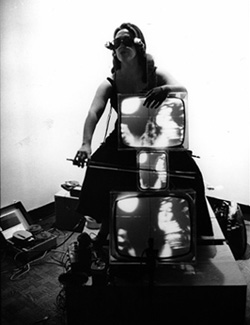
Charlotte Moorman performing Paik's Concerto for TV Cello and Videotapes (1971) at Galeria Bonino, New York, November 23, 1971. © The Estate of Peter Moore/VAGA, NYC. Collection of Barbara Wise, New York

TV Clock, 1989 version. Twenty-four manipulated color televisions; silent; variable dimensions. Santa Barbara Museum of Art, Museum Purchase with funds provided by the Grace Jones Richardson Trust, Wendy and Elliot Friedman, Lillian and Jon B. Lovelace, Leatrice and Eli Luria, Zora and Les Charles, and Lord and Lady Ridley-Tree.